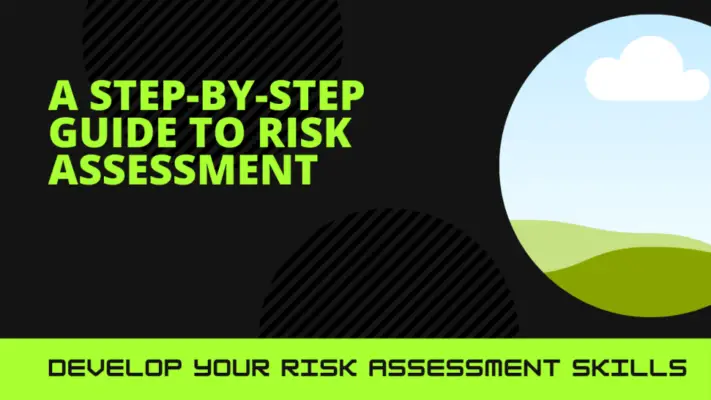Exposure to risk assessment is critical for understanding and managing potential risks. It refers to the contact or interaction between individuals, communities, or ecosystems with a hazardous agent or condition.
The definition of exposure involves assessing the extent and duration of contact and the pathways through which exposure occurs. This article explores the concept of exposure in risk assessment and its significance in evaluating and mitigating risks.
Various factors influence exposure levels, including the nature and concentration of the hazardous agent, as well as individual susceptibility and behaviors.
Methods for measuring and assessing exposure involve quantitative approaches such as biomonitoring, environmental sampling, and modeling techniques. These methods provide valuable data that inform risk management strategies.
Understanding exposure is crucial in risk assessment since it allows for informed decision-making regarding potential health effects or environmental impacts associated with specific hazards.
Moreover, exposure assessment is pivotal in designing effective control measures to minimize risks.
Through case studies highlighting real-world examples of exposure assessments, this article will demonstrate how this process contributes to identifying high-risk scenarios and implementing appropriate preventive measures.
A comprehensive understanding of exposure is essential for ensuring public health protection and sustainable environmental management.

Importance of Understanding Exposure in Risk Assessment
Understanding exposure is crucial in risk assessment as it provides valuable information on the likelihood and magnitude of potential harm, allowing for informed decisions regarding managing and mitigating risks.
The role of exposure assessment in public health cannot be overstated, as it helps identify and quantify the pathways through which individuals may come into contact with hazardous substances or situations.
Public health officials can develop effective strategies to minimize or eliminate health risks to communities by accurately assessing their exposure. This is crucial for protecting the overall well-being of the community.
In addition, accurate exposure data plays a vital role in risk communication. When communicating potential risks to the public, providing accurate information about the level and duration of exposure is essential.
This allows individuals to make informed decisions about their health and take appropriate actions to reduce risks.
Having precise exposure data is crucial for effective risk communication in public health initiatives. Without it, there is a risk of confusion and unnecessary anxiety among the public due to misleading or ineffective communication.
Access to reliable data and a clear understanding of exposure are essential components of risk assessment and communication.
Factors That Influence Exposure Levels
This discussion will focus on three key factors that influence exposure levels in risk assessment:
- Duration and frequency of exposure:
The duration and frequency of exposure refer to the length and number of times an individual is exposed to a hazard. This can significantly impact their overall level of exposure. - Route of exposure:
The route of exposure refers to how a hazardous substance enters the body. It can be through inhalation, ingestion, or skin contact. Each route presents different risks. - Population vulnerability:
Population vulnerability considers certain groups or individuals who may be more susceptible to adverse effects. This vulnerability can be due to age, pre-existing health conditions, or other factors.
Duration and Frequency of Exposure
Risk assessment involves considering the duration and frequency of exposure, which are important factors in determining the potential harm that may result from an adverse event.
When assessing exposure duration in risk assessment, several key points should be taken into account:
- Timeframe: The length of time an individual is exposed to a hazardous substance or situation can significantly impact their level of risk. Longer durations often increase the likelihood and severity of adverse effects.
- Cumulative Exposure: In some cases, repeated exposures over time can result in cumulative effects that may be more harmful than a single instance of exposure. This is particularly relevant when considering chronic diseases or conditions.
- Intermittent Exposure: Occasional or intermittent exposures can still pose significant risks, especially if they occur at critical periods or involve highly toxic substances. Even short-term exposures can lead to adverse health outcomes if they are frequent or occur during vulnerable stages of development.
Considering these factors allows risk assessors to better understand and quantify the potential harm associated with different levels and patterns of exposure duration, aiding decision-making processes regarding prevention or mitigation strategies.
Route of Exposure
One important consideration in evaluating potential harm from an adverse event is the route through which individuals are exposed to hazardous substances or situations.
The routes of exposure refer to the pathways by which a substance enters the body, such as inhalation, ingestion, dermal contact, or injection. Each route of exposure has its own unique characteristics and can result in different types of exposure.
Inhalation involves the intake of substances through breathing contaminated air, while ingestion occurs when substances are swallowed.
Dermal contact refers to direct skin contact with hazardous materials, and injection involves the introduction of substances directly into the bloodstream.
Understanding the specific route of exposure is crucial in risk assessment as it helps determine how individuals may come into contact with harmful agents and consequently develop adverse health effects.
Population Vulnerability
In evaluating population vulnerability, understanding the factors that contribute to differential susceptibility is essential for identifying and addressing potential disparities in health outcomes.
Population vulnerability refers to the degree to which a population is at risk of experiencing adverse health effects due to exposure to certain hazards.
Risk assessment is crucial in determining population vulnerability by examining factors such as age, socioeconomic status, access to healthcare, and pre-existing health conditions.
These factors can influence an individual’s ability to cope with and recover from exposure to hazardous agents. By identifying vulnerable populations, policymakers, and public health officials can develop targeted interventions and strategies to reduce disparities in health outcomes.
Additionally, risk assessment allows for the prioritization of resources towards those populations most in need, ensuring equitable distribution of healthcare services and interventions.

Methods for Measuring and Assessing Exposure
Three key methods for measuring and assessing exposure:
- Environmental monitoring involves collecting data from various environmental media such as air, water, soil, and food to determine the contaminants’ levels.
- Biomonitoring utilizes biological samples such as blood or urine to measure individuals’ internal dose of chemicals.
- Exposure modeling uses mathematical models to estimate the potential exposure levels based on sources, pathways, and behaviors.
Environmental Monitoring
Environmental monitoring plays a crucial role in risk assessment by providing objective data on the levels of various contaminants present in the environment.
Methods for sampling and data analysis are employed to measure and assess exposure to contaminants accurately.
Sampling involves collecting environmental samples such as air, water, soil, or biological specimens from specific locations or populations.
These samples are then analyzed using various techniques to determine the concentration of contaminants present.
Data analysis involves statistical methods to interpret the collected data and estimate the potential risks associated with exposure to these contaminants.
This information is essential for identifying sources of contamination, understanding exposure pathways, and evaluating potential health effects.
Environmental monitoring ensures that risk assessments are based on reliable and accurate data, allowing policymakers and regulators to make informed decisions to protect human health and the environment.
Biomonitoring
Biomonitoring involves the analysis of biological samples to evaluate the presence and concentration of contaminants, providing valuable insights into human exposure to environmental pollutants. This technique offers several benefits in risk assessment.
Firstly, biomonitoring can detect exposures that may not be identified through traditional methods such as air or water sampling.
It allows for a more accurate assessment of an individual’s total exposure, considering multiple routes of exposure and cumulative effects over time.
Additionally, biomonitoring provides information on internal doses and potential health effects, aiding in identifying high-risk populations and informing targeted interventions.
However, biomonitoring also has its limitations. It does not provide information on the source or route of exposure, making it difficult to implement specific control measures.
Furthermore, there is a lack of standardized protocols for biomonitoring across different contaminants, hindering comparability between studies and limiting its utility in risk management decision-making processes.
Exposure Modeling
Exposure modeling is crucial in understanding the distribution and fate of contaminants in the environment.
It allows researchers to simulate and predict human exposure patterns based on factors such as emission sources, transport pathways, and population characteristics.
Exposure prediction is essential for risk assessment as it helps identify potential hazards and inform decision-making processes. There are several exposure assessment methods used in exposure modeling.
These include deterministic models that rely on specific input parameters to estimate exposures and probabilistic models that consider variability and uncertainty in these parameters.
These models can incorporate data from biomonitoring studies to validate their predictions.
By employing advanced statistical techniques, exposure modeling provides valuable insights into the potential risks associated with different environmental contaminants. This enables policymakers to develop effective strategies for risk management and mitigation.
Implications of Exposure Assessment in Risk Management
One important aspect to consider in risk management is the role of exposure assessment and its implications.
Exposure assessment is crucial in determining the potential risks posed by various hazards, such as chemicals or pollutants, to human health and the environment.
It helps identify and quantify the extent of exposure that individuals or populations may experience, informing regulatory decision-making processes.
The implications of exposure assessment on public health are significant as it provides valuable information for understanding the relationship between exposure and adverse health effects.
Moreover, it enables policymakers to establish appropriate guidelines and standards for protecting public health.
Exposure assessment serves as a fundamental tool in risk management by providing essential data necessary for effective decision-making and safeguarding human health and well-being.
- Identification of potential risks.
- Quantification of exposure levels.
- Establishment of protective guidelines.
- Support for evidence-based decision-making.
Case Studies Highlighting the Role of Exposure Assessment
First, when highlighting cases you will examine the importance of exposure assessment in occupational settings where employees are exposed to hazardous chemicals.
Next, we will explore the role of exposure assessment in understanding environmental exposure to air pollution and its potential health effects on communities.
Lastly, we will discuss how exposure assessment is crucial in identifying food contamination and evaluating consumer exposure to harmful substances through food consumption.
These case studies illustrate the significance of accurate and comprehensive exposure assessment in risk management practices.
Occupational Exposure to Hazardous Chemicals
Occupational exposure to hazardous chemicals is a significant concern in risk assessment due to the potential health risks it poses to workers. Occupational health and safety regulations have been established to protect workers from the adverse effects of exposure.
Chemical safety measures, such as hazard communication programs and personal protective equipment, are implemented in workplaces to minimize the risk of exposure.
Exposure assessment plays a vital role in identifying and quantifying the exposure workers may face. It involves evaluating various factors such as the type of chemical, concentration, duration, frequency of exposure, and route of entry into the body.
By conducting exposure assessments, occupational hygienists can determine whether exposure levels exceed permissible limits and recommend appropriate control measures.
Reduce or eliminate risks associated with hazardous chemicals in the workplace. This proactive approach helps safeguard worker health and prevent occupational illnesses related to chemical exposures.
Environmental Exposure to Air Pollution
Environmental exposure to air pollution is a pressing concern in public health due to its detrimental impact on the well-being of populations.
Indoor pollution, a significant component of air pollution, poses a substantial risk to human health. Firstly, volatile organic compounds (VOCs) emitted from household products and activities can result in respiratory disorders such as asthma and allergies.
Secondly, particulate matter (PM), including dust particles and smoke, can penetrate deep into the lungs and cause chronic respiratory diseases.
Lastly, indoor exposure to nitrogen dioxide (NO2) from gas stoves or heaters has been associated with an increased risk of respiratory infections in children.
These health effects highlight the need for effective measures to reduce indoor air pollution and mitigate its consequences on public health.
Food Contamination and Consumer Exposure
Food contamination is a significant concern in public health, as it exposes consumers to potential harm and compromises their well-being. To address this issue, food safety regulations are crucial in minimizing the risk of contamination and ensuring consumer protection.
These regulations set standards for food production, handling, and storage practices that aim to prevent or reduce the presence of harmful substances in food.
Additionally, risk communication plays a vital role in informing consumers about potential hazards associated with food consumption and providing guidance on safe practices.
Effectively communicating risks and promoting awareness, consumers can make informed decisions regarding their food choices and take necessary precautions to protect themselves from exposure to contaminated food. Table 1 presents examples of common contaminants found in various types of food.
| Type of Food | Common Contaminants | Potential Health Effects |
|---|---|---|
| Meat | Salmonella | Gastrointestinal illness |
| Fruits | Pesticide residues | Neurological effects |
| Dairy | Listeria monocytogenes | Miscarriage |
Frequently Asked Questions
How does an understanding of exposure help in conducting risk assessments?
Understanding exposure in risk assessment helps in conducting risk assessments by providing insights into the potential hazards and vulnerabilities associated with a particular situation, enabling effective identification, evaluation, and mitigation of risks.
This knowledge facilitates informed decision-making in risk management processes.
What are some common factors that can affect exposure levels in risk assessment?
Factors that can affect exposure levels in risk assessment include exposure type and duration, the hazard’s concentration or intensity, individual susceptibility, and workplace controls.
Understanding these factors is important for accurately assessing and managing risks.
Are there different methods available for measuring and assessing exposure in risk assessment?
Various methods are available for measuring and assessing exposure in risk assessment. These methods include direct measurement, sampling, modeling, and biomonitoring.
Each method has its advantages and limitations regarding accuracy, cost-effectiveness, and feasibility.
How does exposure assessment contribute to effective risk management strategies?
Exposure assessment is crucial in effective risk management strategies by providing precise and detailed measurements of exposure to hazards.
It allows for the identification of potential risks and aids in the development and implementation of appropriate exposure control measures.
Can you provide real-life examples or case studies demonstrating the importance of exposure assessment in risk management?
Real-world examples and case studies demonstrate the importance of exposure assessment in risk management.
These provide concrete evidence of how understanding and evaluating exposure levels can help identify, mitigate, and manage potential risks effectively.

Conclusion
To sum up, having a good grasp of exposure in risk assessment is essential for the success of risk management.
Factors such as duration and intensity of exposure and individual susceptibility greatly influence exposure levels.
Various methods can be employed to measure and assess exposure accurately.
The implications of exposure assessment are significant in determining appropriate risk mitigation strategies.
Case studies further emphasize the importance of considering exposure when evaluating risks.
It is crucial to have a thorough knowledge of exposure to make well-informed choices and protect oneself against any possible risks.

Chris Ekai is a Risk Management expert with over 10 years of experience in the field. He has a Master’s(MSc) degree in Risk Management from University of Portsmouth and is a CPA and Finance professional. He currently works as a Content Manager at Risk Publishing, writing about Enterprise Risk Management, Business Continuity Management and Project Management.

